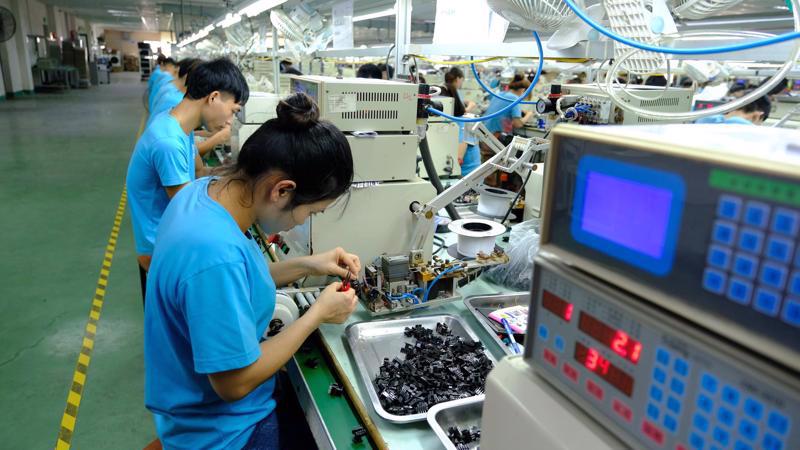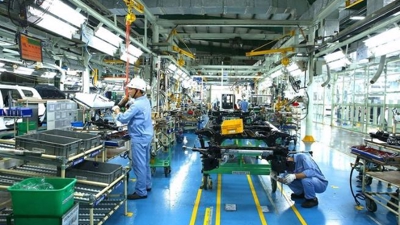Human resources needed for semiconductor industry
Preparing the necessary human resources is crucial for the success of Vietnam’s nascent semiconductor industry.

Many of the world’s major foreign technology companies have begun the process of shifting their chip manufacturing operations to Vietnam, which in turn has created a great deal of opportunities for local businesses. But only when all of the essential elements, such as a plentiful supply of raw materials, sophisticated digital infrastructure, and a skilled labor pool, are in place can the country’s semiconductor industry truly begin to grow and meet its potential.
Engaging in semiconductors
Vietnam has been implementing policies to encourage investment and technological infrastructure and strengthening international cooperation to attract FDI in the development of its semiconductor industry. Alongside this, local businesses will need to enhance their research and development (R&D) capabilities to play a part in promising yet challenging supply chains. This represents a golden time for Vietnamese semiconductor companies to sharpen their competitive edge and confirm their position on the global stage.
Mr. Nguyen Trung Kien, Deputy Head of the Semiconductor Technology Department at the Viettel Group, said the tech giant, as a leading enterprise nationwide in the field of information technology (IT), has invested heavily in R&D over recent years to create high-quality products that meet increasing local and international requirements.
Viettel has recently announced the development of a high-end 5G chip that was successfully tested by its engineers, marking a significant milestone in Vietnam mastering advanced chip technology and paving the way for proactive initiatives in future technologies. The 5G DFE chip is the latest accomplishment of Vietnam in controlling high-end chipsets, which only a few countries can achieve, enabling it to play a more active role in the global semiconductor industry and produce various chips for fields such as AI, 6G, and the Internet of Things (IoT) in the future.
Mr. Kien added that Viettel recognized in 2017 how important yet difficult it would be to acquire chips, and so determined to build a team to develop its own. “This process proved quite challenging due to the limited human resources in Vietnam,” he explained. After building a team for over a year, Viettel began implementing its first chip projects in 2019, when its 5G program commenced. There are three main products in Viettel’s semiconductor business sector: telecommunications products, specifically for 5G networks; dual-use products used for national defense and security; and AIoT (AI for the Internet of Things) products, including AI applications for data centers and edge computing.
Meanwhile, Mr. Nguyen Thanh Yen, General Director of CoAsia SEMI Vietnam, believes Vietnam has a major opportunity with integrated circuit design in the semiconductor industry. Compared to chip production, designing requires less investment and comes with lower risk, making it suitable for countries with young populations who excel in STEM (science, technology, engineering, and mathematics) subjects, as Vietnam does. Through the semiconductor industry, Vietnam can build its human resources, attract foreign companies to set up branches locally, and support domestic startups.
Its semiconductor industry plays an important role in its economy and Vietnam recognizes this as a time with many opportunities. The global semiconductor industry grew by an average of 14 per cent each year from 2001 to 2021 and posted nearly $600 billion in revenue in 2023, with projections of $1 trillion by 2030. It has also been estimated that the global semiconductor industry will need more than 1 million employees by 2030 for all stages of design, production, assembly, packaging, and testing.
In regard to human resources, Ms. Nguyen Thi Le Quyen, Deputy Director of the National Innovation Center at the Ministry of Planning and Investment (MPI), said the ministry has proposed that the government and relevant authorities gradually prepare for the development of the semiconductor industry. The most important matter is to develop the necessary human resources for the industry by 2030 with a vision towards 2045.
Training targets
The MPI, she continued, is currently working on a project to create human resources within these timeframes, based a vision grounded in specific principles. “These are resolute solutions for Vietnam to participate in the semiconductor industry,” she said.
Firstly, ecosystem growth and human resources development must go hand-in-hand. “For example, in addition to establishing goals for human resources development, we will also work to build a positive economic climate by attracting investment and facilitating trade between local and international companies,” she explained. “We will also work on international connections and policy mechanisms.”
Secondly, a variety of training formats are to be applied in the development of courses, since new training takes a lot of time and resources. Therefore, the plan will specifically concentrate on transferring available, relevant training to the semiconductor sector. Furthermore, as all objectives in the sector are transnational in scope, training must aggressively foster international cooperation.
The MPI collaborated recently with the Ministry of Education and Training to work with nearly 20 educational institutions and universities around Vietnam to identify targets and develop plans. The goal is to train approximately 50,000 semiconductor engineers by 2030, with 15,000 for design and 35,000 for production, packaging, testing, and other endeavors. Planning also aims to train 1,300 lecturers who will teach at research institutions, universities, training centers, and businesses. Furthermore, training networks will be expanded to support around 200 facilities.
“We studied and surveyed more than 100 Vietnamese training and educational facilities,” Ms. Quyen went on. “The results demonstrate that these goals are absolutely attainable.”
There are currently about 240 universities in Vietnam, 160 of which focus on teaching engineering and technology subjects, and each year about 134,000 new students enroll at these institutions. It is anticipated that within the next few years some 1,400 students will graduate with a semiconductor major. “Over the past 20 years, Vietnam has taught millions of workers in IT, hundreds of thousands of programmers, and workers in numerous industries linked to the semiconductor industry,” she noted. “These numbers offer a strong basis for accomplishing the target of 50,000 semiconductor engineers being trained in the near future.”
She added that the semiconductor sector will introduce a host of solutions to enhance its human resources, which will include compiling a set of tasks and solutions on the construction and completion of legal frameworks, mechanisms, and preferential policies for training; on infrastructure investment, facilities, and technology that facilitate training; on training; on the mobilization and diversification of resources; on the creation of an ecosystem and market for human resources, in addition to assisting with business development; and on R&D, among others.







